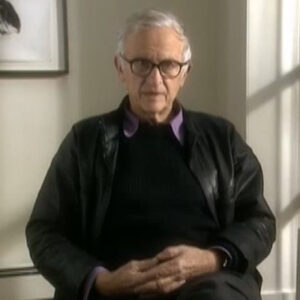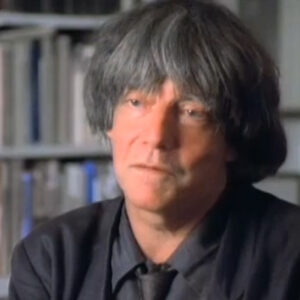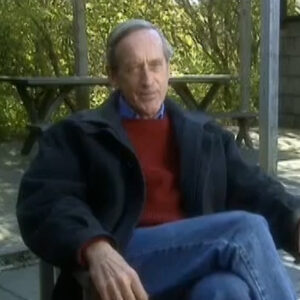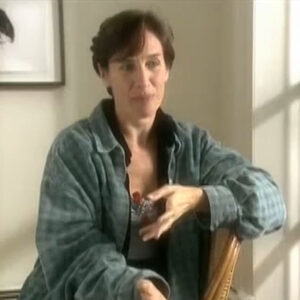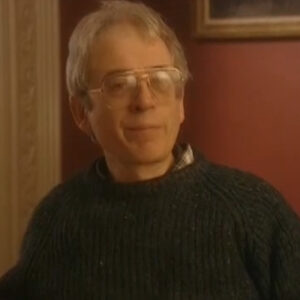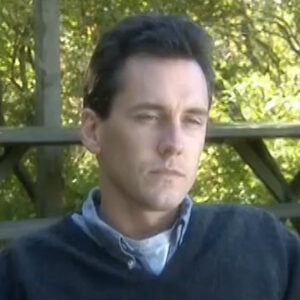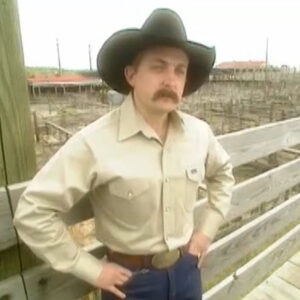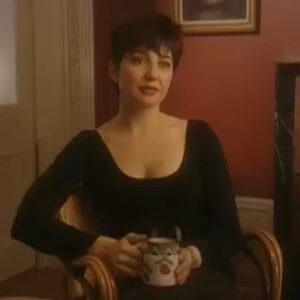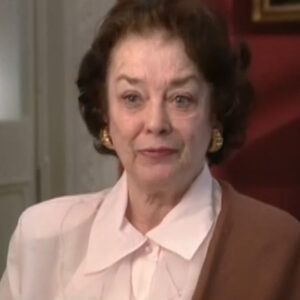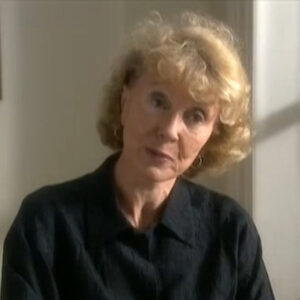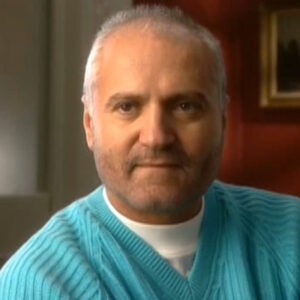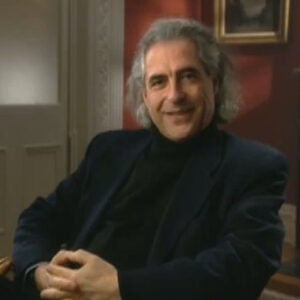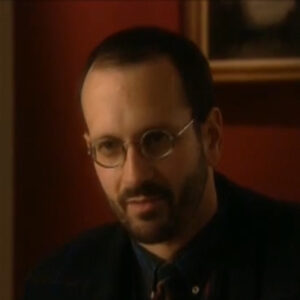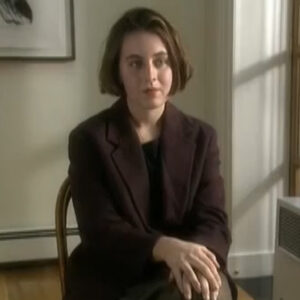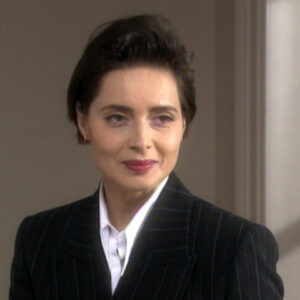Speaker Well, I think fashion photography is essentially reactive and cyclical. And but really this there are two. This is an oversimplification, but there are two polarities. And one, if you like, his formal one is informal and in a sense, on the formal side of it, when when discovered on first emerged, he was reacting against photography, greatly admired in many ways, George Henning and Hugh Ney, who was essentially static and really everyone was about movement. And in a way that that he’s the party then with Pen, who’s his contemporary. And I’ve spoken often before of how these were the two great American masters who set the agenda for postwar fashion photography and so on. There’s always this tendency to lump the two of them together, and they’re very different. They’re really the opposite poles themselves. And in a way, I think this is wherever Don becomes crucial to fashion photography in the 20th century. But then that has a meaning beyond fashion photography as a meaning that photography critics hate. And they don’t want you to attach to fashion photography because they would dismiss it for all sorts of reasons. And the key to how it is more important that I believe and hype transcends that is is somewhere in there. And I don’t know how you put that simply in in the 20th century. Part part of the way women changed. And this goes beyond fashion photography. It’s it’s all free society. There’s a cultural context to this. One of the ways you could express it is to do with movement. Women began to move just literally last weekend in back in England. I bought a photograph of four pounds, an old press photograph of Helen Jacobs. She was an American tennis champion. She was in the US Whiteman Cup team. And it’s fading old brown press photograph. And she’s leaping in the air with her racket wearing shorts. And the big news at the time was this went round the press throughout the world that she was wearing these shorts for a practice session. But the US Weitman Cup governors or whatever they were, forbade her to wear these shorts because they’re indecent when playing for America. And it quoted her saying, but they allow me such great freedom of movement. She wanted to wear them. Well, that battle was won in a way, for women. And that’s right, throughout the centuries. There’s this identification between women and movement that has a relationship with art history in its broadest sense, because the the standard view of art history is and this would come from feminists and people aren’t feminists and artists range in general. It’s accepted that women were depicted throughout art history first while they were painted by men. All the important painters were men until much more recently. The buyers of pictures were men. They had the power, they had the money. The look at pictures were men and women were innocents, often exploited. They were passive. They were they were horizontal. Men were vertical and powerful, powerful positions. Women were horizontal. This is a simplification, but in general, this is true. And so even in the fact that women’s the fact that women start to move at all. And this is expressed in photography and in especially, I think in fashion photography is a 20th century phenomenon, which has to do in a sense, with the further emancipation of women. It’s such a dangerous oversimplification, but I think there’s a broad truth in that. And Avidan was the most intelligent recognizer there, even as a very young man. He was about movement. I mean, he fits into a context like his mentor, Aleksi Brockovich, was about that. But the person who could express this most intelligently and had the most awareness was always Avidan. Plus quite a long answer to your question. So immediately before Avidan becomes a fashion photographer, which he first did in 1944, at that time, you had photographs by Cecil Beeton, which were Barock excess, sometimes surrealist. There was a lot of background, a lot of excess information. And really, you could tell he wasn’t really concerned with a woman. She was a part of a tableau vivant, which was only just about vivants to know nothing. There was no attention on the woman. And in a sense, joining in Hugh Nhé, it had an opposite polarity of neoclassical simplicity. They were elegant. They were impeccable, but they were frozen. They were, in a sense, lifeless. And and Dick’s engagement was with the woman and and in a very interesting way, and almost with her psychology, he he was aware of this and he was aware.
Speaker I think he used the term vulnerability. He was aware of that. He was aware of of what it was for them to be beautiful or he was interested. He was he was exploring it. Let’s say I won’t say aware that he had all the answers. He was he was like a scientist researching this subject. And I think he was analytical. He was analytical and very intelligent about it all. And from a very early stage, he was concerned. He was so conscious of. He wanted to be so conscious of what was really going on, what made a fashion photograph, what the components. And might be that he he did reinvent it in a sense. And it’s a subtle thing. It’s not always. He obviously he started he was a beginner. He had no experience at first is a very subtle thing. But it became very clear this is only my construction of events. Look at the evidence that he was the star of Harper’s Bazaar. This this kid, this ridiculously young guy was the star within a year. He had a little difficult beginning, but within a year he was their star. It was very clear he was he was their chief photographer.
Speaker And he always was ever since isolated elements of what was new in those photographs, just a woman movement blur. Just that force, you know, just one healthy audience. I think that’s what really was what used the word revolution, sweeping and modern, isolated for us again. I put it my question to your answer. What was, well, whatever phrase.
Speaker Well, one of one of the ways in which he expressed this, first of all, using my questions.
Speaker Not yet. One of the way that revolutionized or modernized FaceTime.
Speaker So my questions that were taken out, I was like, well, what I’ve described as his sweeping modernization of fashion photography is it’s not perhaps that easy to see now because he modernized it and he’s put these things in it and they’re there. But they’re quite simple, often technical things in a way. And one was just using focus. This is a technical device on the camera. And he would focus on the model and deliberately throw out of focus the rest of the picture. This straight away made it. It got rid of this confusion of excessive background and backdrop. And you’re forced to concentrate on the model because she’s the only sharp thing in the whole picture.
Speaker Real life, just again. Another thing which characterises this revolution is his feeling for movement now. He’s the first to acknowledge and we all know really that Martin one Kachi started movement in fashion photography in the 1930s.
Speaker And it’s no accident that that evidence bedroom as a child, we know he’s told us it was was papered with evidence, photographs. These are the things that intrigued him so much. It wasn’t those kind of static Hollywood stills, which were the main currency of photography that time. But these photographs of women in action and in a way, I guess is this is maybe one of the things which attracted him to even think of being a fashion photographer. This was the medium where he could have his women in action. And Kachi was a great spur to this. But really, Avidan perfected that. He managed to. He knew for a start that there was that he had to make these pictures in some way, elegant for a start. And I mean, Kachi, perhaps Muchacha was a sports photographer and he was good at getting people in motion, but maybe not really, truly a fashion photographer and often on combined them both also in the book.
Speaker It’s one of the subtext or narrative portrait. You could talk about that using my question.
Speaker Well, I know Kennedy Fraser has said that fashion photographer fashion photography shouldn’t mean too much. It can’t mean too much. And in a way, this isn’t. This is an extracurricular aim of evidence because he was so intelligent about it. He said also that it’s sort of embarrassing that for the first 20 years of his career, he was devoted to the cause of fashion magazines above anything else. And now he finds that slightly embarrassing. But but I don’t think he need to. He did it so well, but that it is going beyond the brief, in a way, in a fashion photograph. This is one of the contradictions inherent in in his pursuit of it to that standard. And even if you like my interest in it. But I think this is this is clearly something which makes it much more interesting to look at these photographs. And he became involved in the psychology of the model in what it meant to be beautiful. And then later on, he took these things even further and he started really within Harper’s Bazaar to criticise the world of beauty and fashion and to say, look what damage it’s doing to these people. This was a very, very daring move him. And in many ways, I mean, he was being a rebel and attacking the medium in which he was operating. And as he said, really, that was an end of it. In a sense. He couldn’t go any further with it. He had to stop. They would have stopped him anyway. But but he snuck a few things in there before the end, which which are the most extreme manifestations of that idea of seeing of questioning what it is we’re involved with here.
Speaker Just choose a few images to talk about that. Interesting idea. When he’s being satirical, when the subject is very rich or dark.
Speaker Well, I mean, that is still the ultimate series in terms of being satirical and darkeys. Is the the serious for Harper’s Bazaar really based on the romances of Liz Taylor, which people may forget now, but exercised all of the tabloid newspapers endlessly at the time, Richard Burton, Eddie Fisher and so on. And he based it first of all, he was introducing a narrative. He wasn’t just showing some pictures of women in dresses. He created a whole story. So instead of just going to Paris and photographing the latest dresses, he was making a tabloid newspaper story himself. And it was even shown that way in the magazine. It was represented like a tabloid within Harper’s Bazaar. So here’s this. Here’s a sensational new story. But it was evidence creation, of course. And some of the most extreme pictures in the image, it was really celebrity hounded by the media. And, of course, the most extreme ones are those where you have the star coming out of hospital with her wrists bandaged. She just obviously had an unsuccessful suicide attempt. And we’re talking the early 1960s in a fashion magazine. This is very strange. And then there’s the guy, her boyfriend, lover or whatever, who’s giving the the finger gesture to the paparazzi who are continually hounding them. It’s almost like he’s doing that to the readers, you know. And you can see that it’s true that maybe this couldn’t have gone much further. This this criticism of the fashion magazines.
Speaker He’s the first serious rooted in Antonioni films.
Speaker Well, yeah, it’s it’s another it’s another aspect. I mean, this is.
Speaker Yeah. I mean, you know, the are we on with this? I don’t know that you have to be careful. Well, when you talk about satirical with with fashion photography, I’m not even sure if it’s the right word. I’m just looking at a Bill Hicks video. The American comedian and he he would be he he’s the one who, in his stage act tells anyone in advertising to go and kill themselves. And he’s really serious about this. And he makes sure they know it’s serious. And he would say, well, if you’re if you’re satirical, you’re just going for the angry dollar, you know, and and he would say, well, it’s still commercial and you can’t transcend that commercial tramp of fashion magazines. Okay, so that’s part one of that answer, which, you know, I like to include. But we know what he means. Part two is another way in which this the satirical side manifests itself.
Speaker And maybe, again, satirical is not the right word. It’s slightly more serious than that, is that everyone was trying to show pictures, which he became very disenchanted with. There was a sort of innocence at the beginning in the 90s, in the mid 1940s, when he began, there was an innocence and optimism. And we know of all the changes in the world that made it no longer possible to maintain that. And in the 1960s, he saw people not caring. You know, he’s he’s devoted to to promote progress and quality. And he saw people themselves being cynical about these values, which he set so much store by. And he saw this reflected in people’s relationships. And he felt those were a lot of alienation in the relationships between people. And he made photographs like this set in a BFA with with two girls in one guy who were never engaged. It was it it was there was an ambiguous sexual thing going on or or asexual, if you like. Nothing much was going on. And they weren’t meeting as minds or anything. And you weren’t you weren’t sure who was with whom and who was not relating to whom. It’s a complicated. And again, he’s really going beyond the brief ever again with with fashion photography. He’s talking about alienation. You know, everything is meant to be light and joy in fashion magazines, not not about alienation. You know, this is this is a difficult commodity to sell. And it’s a very interesting series in that respect.
Speaker In the 70s with a number of libraries are really pushing the envelope. Sexuality, violence was taking off.
Speaker I think in in the 1970s when sexuality for the first time became overt in fashion photography, I think I would. He’s then he’d done it all. He was at the top. I don’t think it’s something I’ve never really seen any photographs of his that I could characterize as, say, wanting to go so far as Helmut Newton, a photographer whom I know he admires a lot. I think he saw Helmut Newton doing it and he admired him greatly for it. And it wasn’t an outline he particularly wanted to pursue in that way. I mean, that in itself was an interesting change in fashion photography. I mean, one of the one of the great philosophers in a way, who’s looked at photography in general in the post-war period, Roland baat, the Frenchman wrote a book in the late 19th Fiserv 1950s called La System de la Mode, the fashion system where he did his deconstruction of what the whole fashion business was about. And he said in this and he was writing 1958 that nothing must happen in the magazine magazines to offend fashions. Bontemps is good tone. There must be very polite. Well, of course, the revolution that Helmut Newton and photographers like him were part of in the 1960s changed all that. And by the 1970s, they were deliberately trying to provoke and to upset the good tone of fashion magazines. And of course, Avalon’s pictures are always going to be of their time in a sense, and they do reflect that.
Speaker But I don’t think he had this agenda to throw it in the reader’s face or be as overt as as photographers like Helmut Newton Engie or Dan is likely to divide separate in two periods periods. How would you do that, a chap? A darker period, just kind of lay that out for us.
Speaker Well, he did. He started in 1944. This was very innocent, very optimistic period. And his work reflected that and pushed it along, too. And I think that lasted, in a sense, always he would do the Paris autumn collections. It would be a great event each year. And that continued really in a way, for 20 years until into the middle of the 60s when things started to change. And then I think he’s moved to Vogue was part of this as well, really Andina real and comes very much into the picture and maybe things. But he was he was feeling disenchanted up to that point and he felt he knew who really and was of course, she had gone to Vogue, that his career had started with her back on Harper’s Bazaar. She was at the height of her power and powers at that time. And I think the fact that she was editor of Vogue was a huge attraction in getting him over there. And really the two of them could work on it. He sort of invented a whole series of visions of women of the 60s with her. And that was a great boost to him. And he was he was really thinking and caring about fashion photographer game for a little while. And then I think he disenchantment came back in the 70s and the regime of that magazine changed and so on. These things can depend on all sorts of factors, which is sometimes person’s own as well as social and historical. And and just a time thing, you know, maybe he was he’d done a lot of what there was to do and just was personally disenchanted by now. And I think it was not a great period for him. And he didn’t put the same amount of care and effort and devotion into it. And it’s understandable.
Speaker The great trio he said he learned from talk about those people should be educated. He would say influences what he was about to hear.
Speaker Well, I think Don’s great mentor was Aleksi brought a vich above all, in a way. And this, again, it’s one of those ways in which the history of fashion photography is a very accurate reflection of that of art history in general in the 20th century. Because, I mean, it’s a commonplace now of art history that many great European painters came over often as refugees in the 1930s. And there were earlier waves and later waves, immigration. But a lot of lot of them ended up in teaching jobs in American colleges or masters to emergent American painters. Then there was a great wave after the war, as we know, the great American painters. This operates in exactly the same way and fashion photography. You have these two great Russians. You have Alexander Lieberman at Vogue and in the 1940s and you already had broad Hovick and other Russian at Harper’s Bazaar. And then in the nineteen thirties he joined in 1934. I think he’s essentially Russian. And this is kind of interesting because evidence background is Russian, of course, as well. And this may be very meaningful. I’m not sure. But Radovich I see is a sort of combination of of various great Russians of the 20th century, sort of three things. He’s he’s filmic. The link with film is hugely important. And the maintaining of momentum through the magazine. And in that sense, I liken him to the great Russian directors like Eisenstein and Vertov. Then he’s like the great Russian constructivist painters.
Speaker The elements of this in broader his own background by illicit ski, who, besides being a constructivist painter, he’s the man who wrote that a book should be like a piece of cinema. But in book form. And then you have Dick Diaghilev and the ballet. And that’s that’s fluidity and spontaneity, I think, are the key words here. And, um, Brockovich knew that all of these went into making a great magazine which had which had pace and the photography that would be about life and vibrancy and these feelings of fluidity and spontaneity. So he was a great designer and a great catalyst for photographers, a great pusher of photographers. And you can call it luck or whatever. But I’m sure Abbadon knew where he wanted to place himself. I mean, he must have gone along to Harper’s Bazaar to see Mr. Brockovich, you know, and Brockovich, this Kindred’s Russian constructivist thing goes through it again. I mean, he was huge, but was teaching at the New School for Social Research Research, a sort of scientific name. His class was called the Design Laboratory. It’s quite a scientific, analytical thing. And there was an element of that in it, too. And I think I think he he forced people who he could see much potential in, like Avidan to think seriously about what this thing was, which is, I think, why this intelligent show so much in his work. But he would he was the great catalyst that made all this happening. And I had the magazine and pushed and pushed and pushed that everyone would always get better. I mean, he said he never praised anyone, ever. So you just had to go on getting better.
Speaker To do now is to go back and summarize that Radovich is the great mentor and again isolate the elements because he really doesn’t know just what was new and to begin to teaching how to look at a photograph for how to lay out a page fluidity, white spaces blur, whatever it is, but just some specific lessons that Abbadon took from him. If you start again.
Speaker BroadVision Away had a book which could say in in photographs, almost everything he would say and words in his classes or in private to his his pupils, his students or the photographers who work with him. And it was his book of ballet photographs. And Irving Penn once called that an exercise in a.. Technique. And he was saying that there’s something about the impact that the photograph must make on a page which goes beyond things like technique. Avidan has never been concerned with technique for its own sake. We’re getting incredibly shot pictures or using the right developer. It’s what the picture must say. It’s the impact it must make on the page. It’s been described in terms of Brockovich lacking that visual shock tactic. There’s some truth in that. And he worked in the magazines, people. It’s easy for them to ignore them. He wanted to make it impossible to ignore their magazines.
Speaker What were some of those techniques really were different. It was taken away.
Speaker It was specifically this brother which broke a lot of the rules that purists would have about laying out photographs. And he has offended and continues to offend many people because he would quite willingly crop a photograph anywhere he wanted. This was anathema to many people at the time, especially the growing American school appears. Photography was sacrosanct. You must not crop a photographer’s work. If he thought it would make more impact on the page, you would crop it. He would lay things out in cinematic sequences. He would run things in strips of eight and run them across the page. You would keep a story flowing through the pages. He would put them on their side. He would put them on the diagonal. He would use. He would blow them up massively. He would encourage his photographers to do that. He loved blurr anything which gave this feeling of spontaneity, of movement. He would go for and he encourages photographers. I think that the thing above all that he wanted was movement and therefore dynamism. Wonderful. You have written that there’s.
Speaker There is a profound connection between this poor creature and his fashion work. If you like. Mean it’s difficult.
Speaker Or if you want to get a summary question, to go back again, what you feel looking back on a tarmac, Scalia, what his singular contribution is being the fashion photography Paltridge, we want to say that maybe fashion design, photography.
Speaker Well, I think what Avedon has done more consciously and better than anyone in fashion photography and is the thing that at this moment interests me most of all about it, is one of the key ways I think it transcends just being magazine illustration. And it has a meaning that goes beyond that. And the keyword here is gesture. Going back to Leonardo da Vinci. He actually wrote that it’s so difficult to paint the intentions of people’s minds. All I can use is gesture and the expression of limbs. Evidence express that very articulately actually throughout his career, saying, well, I yes, I work with surfaces whose meaning is not just superficial. That’s all he has to work with. It’s all Leonardo had to work with you. If you want to show something within a person. Fine. But you have to show what’s outside them, expressing it. And I think everyone understood intuitively and intellectually, really very early on this question of gesture. And it’s one of the ways, of course, fashion photography is slightly specialized. But he understood what limbs and gestures meant. And it I think it’s clear that it is you can look at any of his fashion photographs and see it’s one of the motors of his great fashion photography. And it’s and they tell us things in art history. It’s not a subject that’s yet studied very much. It’s beginning to be just it’s hugely important. And it and it transcends and it can transcend any sort of political criticisms you might have of pictures because there are people doing things and we are all people doing things and they mean things. And and it’s how we express ourselves in something we’re trying to say often comes through very clearly through that. And it’s what he’s always worked with and what I think he has done better than anyone else in the medium.


